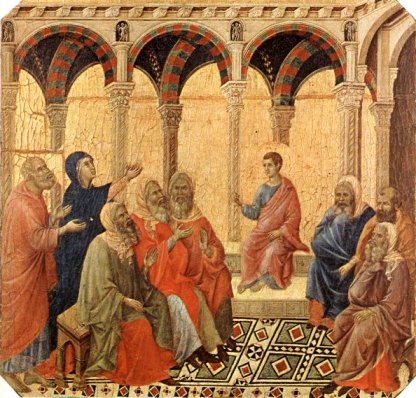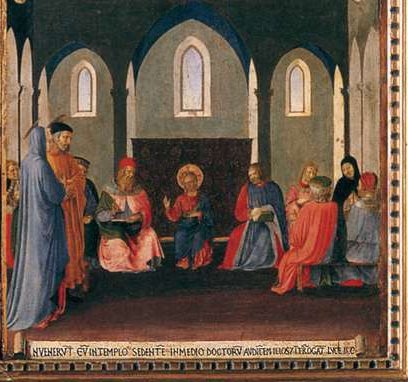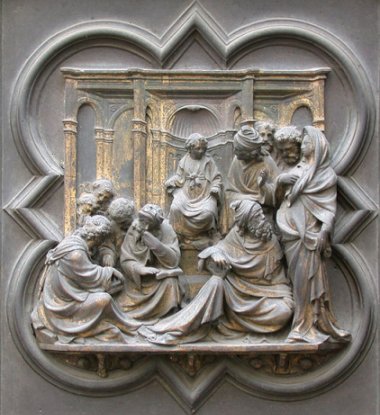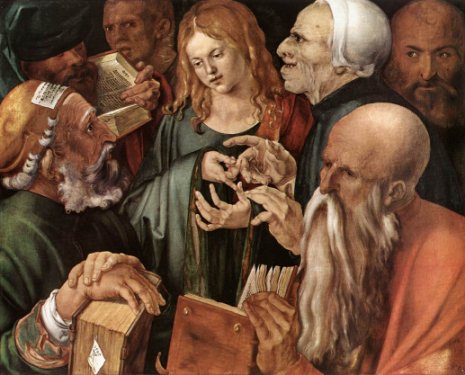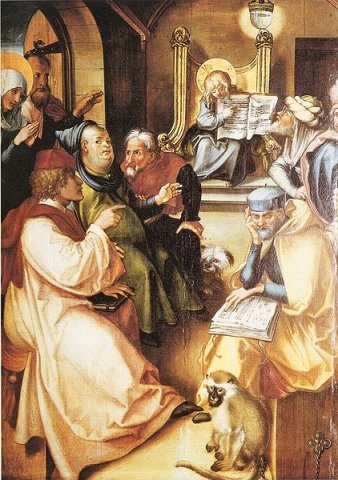|
Christ among the Doctors |
|
| 'And
when he was twelve years old, they went up to Jerusalem after the custom
of the feast. And when they had fulfilled the days, as they returned,
the child Jesus tarried behind in Jerusalem; and Joseph and his mother
knew not of it. But they, supposing him to have been in the company,
went a day's journey; and they sought him among their kinsfolk and
acquaintance. And when they found him not, they turned back again to
Jerusalem, seeking him. And it came to pass, that after three days they
found him in the temple, sitting in the midst of the doctors, both
hearing them, and asking them questions. And all that heard him were
astonished at his understanding and answers. And when they saw him, they
were amazed: and his mother said unto him, Son, why hast thou thus dealt
with us? behold, thy father and I have sought thee sorrowing. And he
said unto them, How is it that ye sought me? wist ye not that I must be
about my Father's business? And they understood not the saying which he
spake unto them. And he went down with them, and came to Nazareth, and
was subject unto them: but his mother kept all these sayings in her
heart. And Jesus increased in wisdom and stature, and in favour with God
and man.' Luke 2: 42 - 52 |
|
I've always regarded this as the most convincing episode in the various infancy gospels. This may be due to my generally agnostic approach to such things, but maybe also because I have spent many years putting together unlikely stories for children. For me, the two gospel stories of the Nativity seems cobbled together to fit a pre-existing agenda, with too many 'get out of jail free' moments at difficult times, particularly in Matthew. In Harry Potter, all you have to do is wave a wand; in Matthew, one character or another has a dream. But this story is different. Anyone who has been a parent, or a grandparent, knows that sickening moment when the child you are responsible for disappears. They will also know that 'what's all the fuss about?' look on the child's face when they are found. As with Christ in this story, their agenda is far more important than yours. Images of this scene generally follow the same pattern; Christ is shown holding forth to the amazed doctors, while Mary and Joseph enter (usually from the left) showing signs of alarm or relief. |
|
|
|
|
|
|
|
| Below are two versions of this theme by Durer; the image on the right forms part of a 'Seven Sorrows of the Virgin' altarpiece now dismantled. I find these rather odd. In both images the doctors are shown as caricatures, in the seven sorrows version quite insultingly so. One doctor appears to be bored to death, while the appearance of the monkey tell us what Durer thinks of them. An anti-Semitic image? | |
|
|
|
